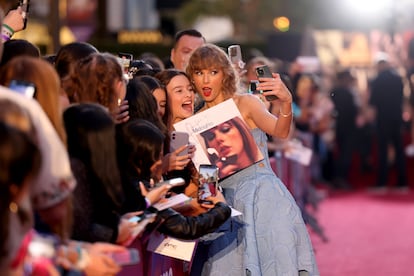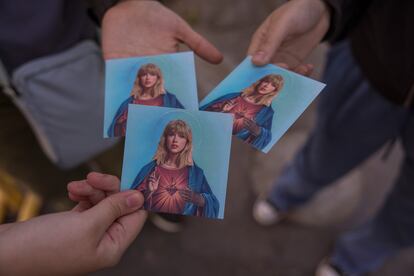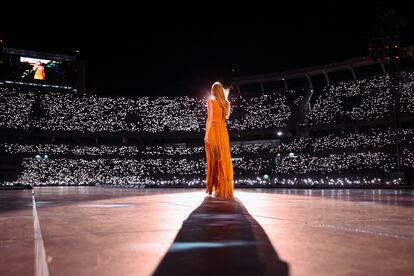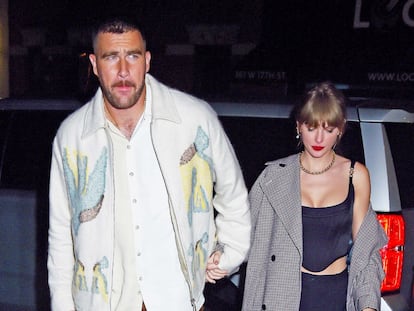A multinational corporation called Taylor Swift: How the singer managed to become a billionaire and boost the economy
The artist has amassed a fortune estimated at $1.1 billion, making her the fifth most powerful woman in the world; The Eras Tour will add around $5 billion to the U.S. economy


The phenomenon is so overwhelming that it is almost impossible to explain. How, and when, and why has a country singer in her early thirties become the biggest money-making machine on the planet? At what point, after being seen by more than three million fans in the last year, did she put $1.1 billion in her bank account? How has she been able to boost — in the Federal Reserve’s own words — the American (and much of the global) economy?
Taylor Swift is not going to reveal her secret. She is inscrutable. With the exception of Time magazine, which just named her person of the year, she has not given interviews for years. Her almost 250 songs speak for her — 10 albums full of songs she has written and sung herself during her 17-year career — as well as the occasional post on social media, where she has 475 million followers. If we want to understand why 2023 became her year, we have to go to the facts and data. These last months, Swift has proven that she is much more than a singer: she is an artist with numbers.
Only taking Spotify streams into account, it is as if everyone in the entire world listened to three of her songs. The platform, where she replaced Bad Bunny as the most listened-to artist — for the first time in a decade there is a woman at the top — reports 26.1 billion streams. Amazon and Apple (where she doubled her 2022 figures; the platform named her artist of the year) also place her as the most listened-to singer of 2023. A monumental wave that can be explained with two arguments: the music that the artist has composed and sung for 17 years, of which she has re-recorded several old albums; and her successful Eras Tour, which began in March and has just ended, before resuming in February 2024 until (in theory) November. All this, supported by a very loyal fan base, who see, analyze and, of course, buy everything, because she treats them as if they were family.
This huge tour — she has given 66 concerts and has 85 left — has caused earthquakes, both economic (it has raised $1.3 billion and generated around $5.5 billion) and literal (in July, in Seattle, a seismometer registered a 2.3 magnitude earthquake caused by her fans). “Something similar happened in Chicago, where the record for hotel occupancy throughout the history of that state [Illinois] was broken, achieving an occupancy of over 44,000 rooms,” says Alfredo Valadez, PhD, a teacher and researcher at CETYS University in Tijuana, Mexico. Because, yes, they are studying Taylor in college. Next year, Berkeley, Stanford and Harvard will teach classes about her, reviewing her lyrics, her literature and her cultural impact.
Not a week goes by without a Swift record or achievement. She is the first person from the world of entertainment, of any category, to be on the prestigious cover of Time magazine — through which 14 U.S. presidents and three popes have passed — since its creation in 1927. They claim that she is “both the writer and hero of her own story.” Forbes, which, like Bloomberg, estimates her net worth at $1.1 billion (twice as much as in 2022), places her as the fifth most powerful woman in the world, also being the first woman from the entertainment industry to enter that ranking, and People named her the most intriguing person of the year.
250 songs in 10 eras
The driving force behind this phenomenon, to a large extent, has been her impressive Eras Tour, an unparalleled musical, artistic, technical and logistical display that has taken her around the United States (53 concerts in 20 cities) and, for the first time, Latin America: Mexico, Argentina and Brazil (13 concerts in four cities). With an average of 60,000 attendees per city, approximately four million people have seen it. In the tour, described as “the greatest show on Earth” by Pollstar, every concert, every night, is unique... and just like the last, too. She sings 44 songs in exactly the same order, except for two surprise songs from the other 200 she has published during her career. She puts body and soul into it, because she knows how expensive and difficult it is to get tickets: she prepared for the tour by singing the setlist on a treadmill and, after the performance, she stays in bed and hardly speaks. “I know I’m going on that stage whether I’m sick, injured, heartbroken, uncomfortable, or stressed,” she told Time. “That’s part of my identity as a human being now. If someone buys a ticket to my show, I’m going to play it unless we have some sort of force majeure.”
That show was Swift’s return to the stadiums after the pandemic. In the beginning, there used to be a tour after the release of each new album; then, Covid-19 arrived. In the summer of 2019 she released her album Lover, which she would have promoted in the summer of 2020. With the hiatus came a change of pace: she released two consecutive albums (Folklore in July 2020; Evermore in December) and a third, Midnights, in October 2022, with a much more personal sound — she is an ever-changing wizard of genres, another reason for her success. They all became bestsellers.
During the pandemic, she gave new music to her confined listeners; after the lockdown, she has given her fans around the world 150 three-and-a-half-hour concerts in which to listen to the songs from those three albums, as well as those from Lover and her first six records. She herself says in her concerts that when she came up with the idea it sounded crazy, but she wanted to go over her 10 studio albums, her 17 years in music. The triple somersault couldn’t have gone better. Her tickets sell like hotcakes; the day they went on sale in the U.S., in November 2022, more than 2.4 million were bought. According to Pollstar, the average price is $253; on resale, according to Fortune, it is almost $2,200. Bloomberg estimates that Swift pockets approximately $13 million every night, which has netted her $700 million, surpassing predictions like those of Billboard (which estimated $590 million) and Forbes (620 million). Of that, she will have around $350 million left. She is now officially a billionaire. And she is not done yet: The Washington Post, with the help of Peter Cohan, an associate professor of management at Babson College in Massachusetts, estimates that if she keeps 85% of the profits from the tour (the usual percentage), she can make as much as $4.1 billion.
But it is not just about the singer’s achievements. It is also the impact she has everywhere she goes: everything she touches turns into gold. Alan Gin, associate professor of economics in the Business School at the University of San Diego, estimates that, if each ticket costs approximately $300, then each attendee spends $1,300 on average, as transportation, lodging, food and clothing easily take another $1,000. Because of course, any Taylor fan worth their salt will dress accordingly, wearing something inspired by one of her eras or her looks, as well as a handful of friendship bracelets, which have also had a sales boom: up to 500%, according to Time. “Swift helps the local economy and support local businesses,” says the professor via videoconference. Every time the singer passes through a city, she leaves millions of dollars in her wake. It is estimated that the six concerts she did in California in August contributed $320 million to the state. Even the Federal Reserve has acknowledged that her activity will add approximately $5 billion to the US economy.

Her global leap, to which she is not used to, will bring her much joy. Until now, her exploration beyond the United States and Canada had been mostly limited to the United Kingdom, Australia or Japan. Her first time in Latin America was a success: Arturo Vega, president of the Chamber of Commerce, Services, and Small Tourism of Mexico City, explains that the artist “left a very positive mark, of more than 1 billion pesos,” approximately $60 million, with the four concerts that she gave in August. That was 25% more than expected. “It had an impact not only on the local consumer sector, which is what usually happens with these concerts, but also on the tourism sector,” he says.
It is not unheard-of that cities temporarily change their name in her honor, such as Taylor Swift, Arizona (normally Glendale); or that some world leaders even ask her to visit their cities or countries. In July, Justin Trudeau begged Swift not to subject him to “another cruel summer” (Cruel Summer is one of her most famous songs) and please, go to Canada. She has obliged with, so far, nine concerts. In some of the six that she gave in Toronto, where there were approximately 250,000 seats available, more than 30 million people registered to get tickets. The many that did not make it around the world seem to have gone to the cinema to see the star: her The Eras Tour hit the theaters in October and has already become the best premiere of a concert in theaters in the U.S. and in the 94 countries where it has been released. With a production cost of between $10 and $20 million (with no platforms or production companies behind it: it is all the singer’s doing), it has raised $250 million, only surpassed by the $261 raised by Michael Jackson’s This Is It in 2009, according to Variety.

Stolen and re-recorded albums
Swift’s income does not just come from this tour. There is also her music. It is a musical venture forged with time, power and dexterity. If in October Bloomberg thought that her streams had contributed $120 million to her fortune, now Billboard believes that, just this year and with Spotify, she made $100 million. But that also comes after she left the platform in 2014 complaining about its unfair payments, before returning in 2017, when she finally deemed them acceptable. In 2015, she also threatened to leave Apple Music for refusing to pay royalties to artists during the user’s three-month trial period. After her threat, the company reconsidered. Her model is also different from that of other singers: she earns more because she owns the masters of eight of her 10 albums, and being a singer as well as a writer, she has more rights. When she signed with Universal in 2018, she negotiated higher royalties. There is a reason for that.
It all started in her native Pennsylvania, where she began singing from a very young age with a natural talent that her parents, Andrea and Scott, were able to recognize. The girl wanted country music, so they took her to the cradle of country music: Nashville, Tennessee. There, singing in a café, she was discovered by a producer, Scott Borchetta, and in 2006, before turning 16, she released her first album with his production company, Big Machine. The rest is history. That debut would be followed by nine other albums that have ranged from country to pop and indie.
Since those early days, her parents (who have been divorced since 2011) have continued to be their daughter’s guides and business companions. Taylor Swift Inc. is an immense family business spread across a conglomerate of companies that bear the name of the artist, her initials or her favorite number (13, like her date of birth, December 13, 1989). That is why disappointment and sadness were a family matter during the hardest moment of Swift’s professional life, when she lost her music in 2018. That is when Borchetta sold businessman Scooter Braun, Swift’s archenemy, all of Big Machine for approximately $330 million; the package included her masters, copyrights, lyrics, videos and more. According to the singer, she begged Borchetta to sell it to her — or at least not to put it in Braun’s hands. He did not budge. It was goodbye to everything she had built since 2006.
Swift showed her anger and pain on Tumblr, in a long letter where she talked about her “stolen” albums — as she always refers to them — and accused Braun of taking her songs: “Music I wrote on my bedroom floor and videos I dreamed up and paid for from the money I earned playing in bars, then clubs, then arenas, then stadiums,” she wrote. “Scooter has stripped me of my life’s work, that I wasn’t given an opportunity to buy. Essentially, my musical legacy is about to lie in the hands of someone who tried to dismantle it,” she continued. “Never in my worst nightmares did I imagine the buyer would be Scooter. Any time Scott Borchetta has heard the words ‘Scooter Braun’ escape my lips, it was when I was either crying or trying not to. He knew what he was doing; they both did. Controlling a woman who didn’t want to be associated with them. In perpetuity. That means forever.” Not so much: just a year and a half later, he sold the artist’s catalog to an investment group called Shamrock Capital. He had paid $140 million; he sold it for $405.
Then, taking advantage of a legal loophole, in 2020 Swift managed to start re-recording all that material, because although she did not have rights to the albums, she did have the rights to the compositions themselves. “The re-recording project is just a phenomenal achievement,” says British marketing expert Kat McKenna, author of a book about the artist and the fan phenomenon entitled Look What You Made Me Do, which will be published in the spring. “I’m just so impressed by her business acumen to be able to just think again, to do it that fast, to the point where record labels have now put clauses in their contracts so others can’t do it. She does these things that no artist has ever done.” That is why she fought so hard for her royalties, and everything revolves around her music. She does not make any money with ads, brands or advertising campaigns.

Swift has already re-recorded four of those albums, which retained their original names plus “Taylor’s Version”: Fearless and Red in 2021; Speak Now and 1989 in 2023. The latter, released in October, managed to sell 1.7 million copies in one week, more than the 1.3 million of the original 2014 release. It is the best release of an album, by any artist, since 2015. The fans, which span several generations, are buying them again and listening to them along with the current ones, which in turn has put them back on the charts.
As for her personal life, this summer she started a romantic relationship with Travis Kelce, one of the best-known, most powerful and richest players in the NFL (he earns $14 million a year). This has placed her in the media spotlight of an audience that is not hers. According to a Morning Consult poll from March, 53% of Americans declare themselves Swift fans; her U.S. fandom, 52% female and 48% male, “is largely made up of millennials, and leans white, suburban and Democratic.”
She will return to the stage in February, in Tokyo, to continue through Singapore, Australia, France, Sweden, the United Kingdom, Germany, then back to the United States, Canada... she will give another 85 concerts until the end of November. The economic impact of that tour remains to be seen. How about some new music? Nobody knows. For now, she still has two of her first six albums left to re-record: the first, Taylor Swift (2006), and the last, the highly anticipated Reputation (2017). She still has some work to do to recover her name and reputation. Symbolically — because when it comes to having, she already has it all.
Sign up for our weekly newsletter to get more English-language news coverage from EL PAÍS USA Edition
Tu suscripción se está usando en otro dispositivo
¿Quieres añadir otro usuario a tu suscripción?
Si continúas leyendo en este dispositivo, no se podrá leer en el otro.
FlechaTu suscripción se está usando en otro dispositivo y solo puedes acceder a EL PAÍS desde un dispositivo a la vez.
Si quieres compartir tu cuenta, cambia tu suscripción a la modalidad Premium, así podrás añadir otro usuario. Cada uno accederá con su propia cuenta de email, lo que os permitirá personalizar vuestra experiencia en EL PAÍS.
¿Tienes una suscripción de empresa? Accede aquí para contratar más cuentas.
En el caso de no saber quién está usando tu cuenta, te recomendamos cambiar tu contraseña aquí.
Si decides continuar compartiendo tu cuenta, este mensaje se mostrará en tu dispositivo y en el de la otra persona que está usando tu cuenta de forma indefinida, afectando a tu experiencia de lectura. Puedes consultar aquí los términos y condiciones de la suscripción digital.
More information
Archived In
Últimas noticias
Most viewed
- Sinaloa Cartel war is taking its toll on Los Chapitos
- Oona Chaplin: ‘I told James Cameron that I was living in a treehouse and starting a permaculture project with a friend’
- Reinhard Genzel, Nobel laureate in physics: ‘One-minute videos will never give you the truth’
- Why the price of coffee has skyrocketed: from Brazilian plantations to specialty coffee houses
- Silver prices are going crazy: This is what’s fueling the rally










































